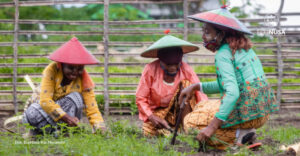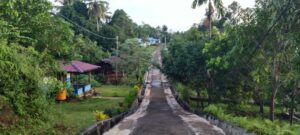
Pegunungan Arfak Regency has distinctive ecosystem. Spreading on 2,600 square kilometers areas, Pegunungan Arfak has three different types of ecosystem, namely lowland rainforests, rainforests on mountain foot, and mountain slopes rainforests. It is no wonder that the ‘bird head’ region with cool weather in West Papua becomes habitat of assorted flora and fauna.
West Papua Natural Resources Conservation Agency (BKSDA) estimates there are 110 mammal species, 320 bird species, and 2,770 orchid types living in Pegunungan Arfak. Among the hundreds of bird species, one of the aves families grabbing global attention is the family of Paradisaedae, namely cenderawasih. There are four species of cenderawasih found only in Pegunungan Arfak.
They are Parotia Arfak (Parotia sefilata), Vogelkop Superb-bird-of-paradise (Lophorina niedda), Paradigalla Ekor Panjang (Paradigalla carunculata), and Astrapia Arfak (Astrapia nigra). Vogelkop Superb Bird-of-Paradise is categorized as young species because it was found in 2016 when ornithologist Edwin Scholes and wildlife photographer Tim Laman conducted a research on Bird-of-Paradise project in Tanah Papua forests.
Hard to Find
The four cenderawasih birds here are not simply charming visually, but their deeds to attract opposite sex is also appealing to observe. They dance before the opposite sex birds as if “clever seducer.”
Read also: Cenderawasih’s Spectacular Dance to Lure Mate
Both male and female Arfak Astrapia has long tail. The male has 60 centimeters long tail and the female 50 centimeters. Not only in terms of size, the male Arfak Astrapia has assorted color of feather. It has green on the chest, yellow stripe under its eyes with purplish blue crown. Meanwhile, the female one has monotonous tone with black color on its head and brown color covering all over its body.
Arfak Astrapia is hard to find bird. Only small number of documentation that record their behavior, let alone to get the way their display to attract their mates. Tim Laman reckoned the fact when he was in search of trees in which Arfak Astrapia perform their actions.
Tim, Ed, and Zeth Wongor, Pegunungan Arfak tourist guide, started to go to the jungle at 04.30 WIT before daybreak. They tracked a “click” sound of Arfak Astrapia to lead to the tree in which they perform their actions. On the last day of the trip, Tim could capture a male display by whirling under their bodies.
“One of the few number of documentation of this bird (Arfak Astrapia) is due to the fact that it is hard to find the spot in which they displayed their mates. You can go up to the surrounding forest and perhaps see them to watch bird. However, to get unique picture of their behaviour, you should find the spot where they perform their action and spend much of time in the forests and wake up before dawn,” said Tim Laman.
Read also: Egek Local Wisdom, Struggle to Protect Malaumkarta Raya Forests
The Long-tailed Paradigalla behavior has minimum documentation. Despite the digital search, there is bird encyclopaedia with information on the unique characteristic of Long-tailed Paradigalla during mating season. The Long-tailed Paradigalla is categorized into monomorphic bird. In other words, both male and female have similar characteristics. The difference deals with the size of the body as male is 37 centimeters long and female 35 centimeters. They have similar color with yellow-blue-red surrounding the eyes and beak and black color covering the whole body.
Ballerina
The real display of endemic bird in Pegunungan Arfak is performed by Parotia Arfak and Vogelkop Superm Bird-of-Paradise. Both birds have distinctive choreography as if magic dance to ensure the opposite sex. Fortunately, they are relatively easy to find. The display is usually performed in the morning or afternoon.
Before dancing, Parotia Arfak cleans up the dance floor from leaves, branches or anything that might distract the performance. According to David Attenborough, an English naturalist and broadcaster, this also affect the possibility of female to pay a visit to the ‘dance floor’. The female will only pay a visit and watch the dance only when the stage is clean.
“It (Parotia Arfak) starts the dance by bowing down. Then its blue eyes will display yellow color at a glimpse,” said David.
Read also: Ridho Hafiedz Captivated by Birds of Paradise in the Land of Papua
Such appealing choreography does not happen overnight. Since its teenage, when its whole body is brown covered, Parotia Arfak has exercised each dancing movement. According to Ed Scholes, the choreography exercise was even done alone after they watched the adult bird dancing as human who practiced alone.
“They rehearsed together. A young male acted as a female while the other male was dancing. The play their roles each other,” said Ed.
Protecting Forests
Pegunungan Arfak ecosystem is the treasure of the world. The indigenous peoples such as Hatam tribe, Sough, Meyakh and Moley, from generation to generation have protected ecosystem using their own local wisdom. They have many kinds of local terminologies to translate practices of local wisdom. Hatam tribe for instance, has made local wisdom so-called igya ser handjo to order their life space and ecosystem protection. Literally, igya ser hanjob means protecting the boundary.
In daily life, Hatam tribe performs their activities based on igya ser hanjob space division. A susti area is used for residence, gardening, and ritual house. Nimahamti is the buffer zone in which people can go hunting and gathering food upon the permit given by the tribal chief. Meanwhile, bahamti is primary forest zone in which destruction is banned. They do it to protect their forests and resources including cenderawasih in West Papua.
Editor: Leo Wahyudi & Nur Alfiyah







